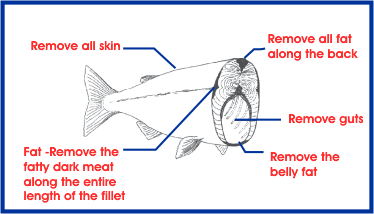
Selecting Fish
- Avoid fish with loose scales, sunken eyes, discolored skin, and white, bloody, or slimy gills. Healthy fish have bright, clear eyes and red gills.
- The size and species of a fish can impact how much mercury you are exposed to. Smaller fish that are low on the food chain, like bluegill and crappie, tend to be lower in mercury than larger fish that are on the top of the food chain, like bass, walleye, and catfish.
- Check the Indiana Fish Consumption Advisory before eating local fish and the FDA/EPA Advice about Eating Fish to reduce exposure to contaminants.
- To identify the fish you plan to eat, visit the Indiana Department of Natural Resources Fish Identification page.
Preparing Fish
- PCBs can be reduced by removing the fat, skin, and organs of the fish. Refer to the diagram to the diagram below from the Wisconsin Department of Natural Resources on how to clean a fish. Mercury cannot be reduced this way.

- Washing fish will not remove contaminants. You do not need to wash fish before cooking.
- Keep fish frozen until you are ready to cook it. If your fish is packaged, remove the packaging before thawing. Thaw until the fish is icy but no longer hard. Avoid thawing fish in the microwave because the fish may thaw unevenly.
Cooking Fish
- Fish should be cooked until flaky and reaches 145°F to reduce the risk for foodborne illness. Use a calibrated meat thermometer to ensure proper cooking. Thicker fish will need to cook longer than thinner pieces.
- Fish will become opaque, which means you cannot see light through it, when it is done.
- Leftover fish can be saved by refrigerating in a tightly sealed container. It should be consumed within 3-4 days.
Fish Recipes
For some inspiration for meals using fish go here.
